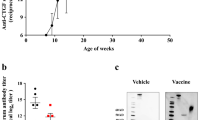Abstract
Background
Nephrin is an essential protein for maintaining the normal structure of podocyte foot processes and the glomerular filtration barrier. To analyze the mechanism of proteinuria and nephrotic syndrome, we previously reported on a new method of producing polyclonal anti-nephrin antibody by genetic immunization. In the present paper, we investigate the effect of signal peptide sequence cDNA on the characteristics of polyclonal anti-nephrin antibodies induced by genetic immunization.
Methods
Five fragments of nephrin cDNA with or without signal peptide sequence were inserted into the pTARGET™ vector. Rats were immunized with these vectors by the gene gun method. Sera obtained from rats at 14 weeks following immunization were analyzed by Western blotting, immunoprecipitation, flow cytometry and immunohistochemistry.
Results
Four different antibodies induced by cDNA encoding nephrin protein fragments without signal peptide showed antigen site-specific binding to fragmented glycosylation-disturbed nephrin proteins. These antibodies also reacted to a glycosylation-disturbed full-length nephrin protein (inhibited by tunicamycin), but did not react to either a native nephrin protein or a fully glycosylated conformational nephrin protein. Four different antibodies induced by cDNA encoding nephrin fragments with signal peptide showed an antigen site-specific binding to glycosylation-disturbed nephrin protein fragments. In addition, these antibodies reacted to both a native nephrin protein and a full-length glycosylated conformational nephrin protein.
Conclusions
The absence of signal peptide sequence cDNA in the expression vector produced antibodies specific for glycosylation-disturbed proteins, while its presence produced antibodies that bound to native or fully glycosylated conformational protein.




Similar content being viewed by others
References
Tryggvason K, Patrakka J, Wartiovaara J. Hereditary proteinuria syndromes and mechanisms of proteinuria. N Engl J Med. 2006;354:1387–401.
Yan K, Khoshnoodi J, Ruotsalainen V, Tryggvason K. N-linked glycosylation is critical for the plasma membrane localization of nephrin. J Am Soc Nephrol. 2002;13:1385–9.
Khoshnoodi J, Hill S, Tryggvason K, Friedman DB. Identification of N-linked glycosylation sites in human nephrin using mass spectrometry. J Mass Spectrom. 2007;42:370–9.
Gerace L, Gilmore R, Johnson A, Lazarow P, Neupert W, O’Shea E, et al. The endoplasmic reticulum. In: Alberts B, Johnson A, Lewis J, Raff M, et al., editors. Molecular biology of the cell. 4th ed. New York: Newton Press; 2004. p. 689–709.
Kitamura M. Endoplasmic reticulum stress in the kidney. Clin Exp Nephrol. 2008;12:317–25.
Aoyama T, Kamata K, Yamanaka N, Takeuchi Y, Higashihara M, Kato S. Characteristics of polyclonal anti-human nephrin antibodies induced by genetic immunization using nephrin cDNA. Nephrol Dial Transplant. 2006;21:1073–81.
Emr S, Kelly R, Pelham HR, Schekman G, Schiavo JL, Schwarth K. What is the purpose of glycosylation? In: Alberts B, Johnson A, Lewis J, et al., editors. Molecular biology of the cell. 4th ed. New York: Newton Press; 2004. p. 735–6.
Harlow E, Lane D. Epitope mapping. In: Harlow E, Lane D, editors. Using antibody: a laboratory manual. New York: Cold Spring Harbor Laboratory Press; 1999. pp. 382–385.
Nakajo A, Khoshnoodi J, Takenaka H, Hagiwara E, Watanabe T, Kawakami H, et al. Mizoribine corrects defective nephrin biogenesis by restoring intracellular energy balance. J Am Soc Nephrol. 2007;18:2554–64.
Inagi R, Kumagai T, Nishi H, Kawakami T, Miyata T, Fujita T, et al. Preconditioning with endoplasmic reticulum stress ameliorates mesangioproliferative glomerulonephritis. J Am Soc Nephrol. 2008;19:915–22.
Cybulsky AV, Takano T, Papillon J, Bijian K. Role of the endoplasmic reticulum unfolded protein response in glomerular epithelial cell injury. J Biol Chem. 2005;280:24396–403.
Cybulsky AV, Takano T, Papillon J, Khadir A, Liu J, Peng H. Complement C5b-9 membrane attack complex increases expression of endoplasmic reticulum stress proteins in glomerular epithelial cells. J Biol Chem. 2002;277:41342–51.
Inagi R, Nangaku M, Onogi H, Ueyama H, Kitao Y, Nakazato K, et al. Involvement of endoplasmic reticulum (ER) stress in podocyte injury induced by excessive protein accumulation. Kidney Int. 2005;68:2639–50.
Bijian K, Cybulsky AV. Stress proteins in glomerular epithelial cell injury. Contrib Nephrol. 2005;148:8–20.
Acknowledgments
S. Naito and K. Kamata equally contributed to this article. We thank Dr. Michihito Okubo for his critically reading and helpful suggestion to this article, and Mrs. Naoko Ishigaki for technical assistance.
Author information
Authors and Affiliations
Corresponding author
About this article
Cite this article
Naito, S., Kamata, K., Aoyama, T. et al. Antigen-binding abilities of anti-nephrin antibody are prescribed by signal sequence of expression vector in genetic immunization. Clin Exp Nephrol 15, 339–345 (2011). https://doi.org/10.1007/s10157-010-0399-4
Received:
Accepted:
Published:
Issue Date:
DOI: https://doi.org/10.1007/s10157-010-0399-4




